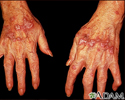Lichen planus
Lichen planus is a condition that forms a very itchy rash on the skin or in the mouth.
The exact cause of lichen planus is unknown. It may be related to an allergic or immune reaction.
Risks for the condition include:
- Exposure to certain medicines, dyes, and other chemicals (including gold, antibiotics, arsenic, iodides, chloroquine, quinacrine, quinine, phenothiazines, and diuretics)
- Diseases such as hepatitis C
Lichen planus mostly affects middle-aged adults. It is less common in children.
Symptoms
Mouth sores are one symptom of lichen planus. They:
- May be tender or painful (mild cases may not cause pain)
- Are located on the sides of the tongue, inside of the cheek, or on the gums
- Look like bluish-white spots or pimples
- Form lines in a lacy network
- Gradually increase in size
- Sometimes form painful ulcers
Skin sores are another symptom of lichen planus. They:
- Usually appear on the inner wrist, legs, torso, or genitals
- Are extremely itchy
- Have even sides (symmetrical) and sharp borders
- Occur alone or in clusters, often at the site of a skin injury
- May be covered with thin white streaks or scratch marks
- Are shiny or scaly looking
- Have a dark, violet color
- May develop blisters or ulcers
Other symptoms of lichen planus are:
- Dry mouth
- Hair loss
- Metallic taste in the mouth
- Ridges in the nails
Exams and Tests
Your health care provider may make the diagnosis based on the appearance of your skin or mouth lesions.
A skin lesion biopsy or biopsy of a mouth lesion can confirm the diagnosis.
Treatment
The goal of treatment is to reduce symptoms and speed healing. If your symptoms are mild, you may not need treatment.
Treatments may include:
- Antihistamines
- Medicines that calm down the immune system (in severe cases)
- Lidocaine mouthwashes to numb the area and make eating more comfortable (for mouth sores)
- Topical corticosteroids or oral corticosteroids to reduce swelling and lower immune responses
- Corticosteroid shots into a sore
- Vitamin A as a cream or taken by mouth
- Other medicines that are applied to the skin
- Dressings placed over your skin with medicines to keep you from scratching
- Ultraviolet light therapy
Outlook (Prognosis)
Lichen planus is usually not harmful. Most often, it gets better with treatment. The condition often clears up within 18 months, but may come and go for years.
If lichen planus is caused by a medicine you are taking, the rash should go away once you stop the medicine.
Possible Complications
Mouth ulcers that are present for a long time may develop into oral cancer.
When to Contact a Medical Professional
Contact your provider if:
- Your skin or mouth lesions change in appearance
- The condition continues or gets worse, even with treatment
- Your dentist recommends changing your medicines or treating conditions that trigger the disorder
References
James WD, Elston DM, Treat JR, Rosenbach MA, Neuhaus IM. Lichen planus and related conditions. In: James WD, Elston DM, Treat JR, Rosenbach MA, Neuhaus IM, eds. Andrews' Diseases of the Skin: Clinical Dermatology. 13th ed. Philadelphia, PA: Elsevier; 2020:chap 12.
Patterson JW. An approach to the interpretation of skin biopsies. In: Patterson JW, ed. Weedon's Skin Pathology. 5th ed. Philadelphia, PA: Elsevier; 2021:chap 2.
Lichen planus - close-up - illustration
Lichen planus - close-up
illustration
Lichen nitidus on the abdomen - illustration
Lichen nitidus on the abdomen
illustration
Lichen planus on the arm - illustration
Lichen planus on the arm
illustration
Lichen planus on the hands - illustration
Lichen planus on the hands
illustration
Lichen planus on the oral mucosa - illustration
Lichen planus on the oral mucosa
illustration
Lichen striatus - close-up - illustration
Lichen striatus - close-up
illustration
Lichen striatus on the leg - illustration
Lichen striatus on the leg
illustration
Lichen striatus - close-up - illustration
Lichen striatus - close-up
illustration
Lichen planus - close-up - illustration
Lichen planus - close-up
illustration
Lichen nitidus on the abdomen - illustration
Lichen nitidus on the abdomen
illustration
Lichen planus on the arm - illustration
Lichen planus on the arm
illustration
Lichen planus on the hands - illustration
Lichen planus on the hands
illustration
Lichen planus on the oral mucosa - illustration
Lichen planus on the oral mucosa
illustration
Lichen striatus - close-up - illustration
Lichen striatus - close-up
illustration
Lichen striatus on the leg - illustration
Lichen striatus on the leg
illustration
Lichen striatus - close-up - illustration
Lichen striatus - close-up
illustration
Review Date: 11/18/2022
Reviewed By: Elika Hoss, MD, Assistant Professor of Dermatology, Mayo Clinic, Scottsdale, AZ. Also reviewed by David C. Dugdale, MD, Medical Director, Brenda Conaway, Editorial Director, and the A.D.A.M. Editorial team.

















